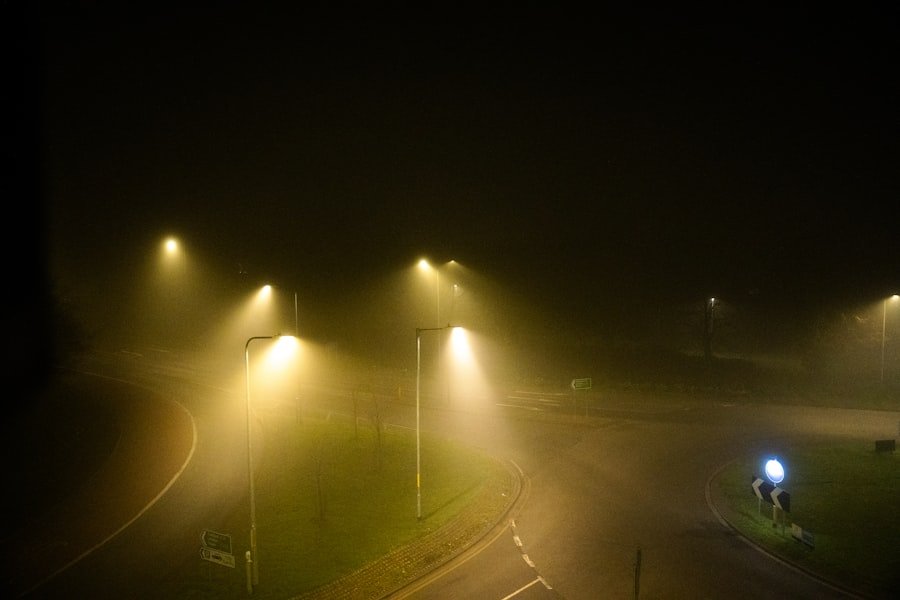Foggy headlights are a common issue that many vehicle owners encounter, and understanding the underlying causes is essential for effective remediation. The primary culprit behind this phenomenon is the degradation of the plastic lens that covers the headlight bulb. Most modern vehicles utilize polycarbonate plastic for their headlight lenses due to its lightweight and durable properties.
However, this material is susceptible to environmental factors such as UV radiation, road debris, and harsh weather conditions. Over time, exposure to these elements can lead to oxidation, resulting in a cloudy or yellowed appearance that significantly diminishes the effectiveness of the headlights. In addition to UV exposure, other factors contribute to the fogging of headlights.
For instance, improper cleaning techniques can exacerbate the problem. Using abrasive materials or harsh chemicals can scratch the surface of the lens, leading to further cloudiness. Moreover, moisture can become trapped inside the headlight assembly due to poor seals or cracks, causing internal fogging.
Understanding these causes is crucial for vehicle owners who wish to maintain optimal visibility and safety while driving.
Key Takeaways
- Foggy headlights can be caused by oxidation, UV exposure, and environmental factors.
- Severity of foggy headlights can be assessed by the level of haziness and yellowing.
- Choose cleaning products specifically designed for headlights to avoid damage.
- Preparing headlights for cleaning involves taping off surrounding areas and wet sanding if necessary.
- Regular maintenance and using DIY methods can help prevent and clean foggy headlights.
Assessing the Severity of the Foggy Headlights
Before embarking on a cleaning regimen, it is vital to assess the severity of the foggy headlights. This evaluation will help determine whether a simple cleaning solution will suffice or if more extensive restoration efforts are necessary. A straightforward method for assessing the condition of your headlights involves examining their clarity during both day and night.
If you notice a significant reduction in brightness or a yellowish tint, it indicates that the fogging has progressed beyond a superficial level. Another effective way to gauge severity is to perform a simple water test. Spraying water on the headlight lens can help you determine how much light is being refracted.
If the water beads up and rolls off without penetrating the surface, it suggests that the lens is still relatively intact.
By accurately assessing the condition of your headlights, you can tailor your cleaning strategy accordingly.
Choosing the Right Cleaning Products

Selecting appropriate cleaning products is crucial for effectively restoring foggy headlights without causing further damage. Many commercial headlight restoration kits are available on the market, each designed with specific formulations to tackle oxidation and cloudiness. These kits often include sandpaper or polishing pads, along with a specialized cleaning solution that helps break down the oxidized layer on the lens. When choosing a kit, look for one that includes UV protection to prevent future degradation. For those who prefer a more natural approach, several household items can also be effective in cleaning foggy headlights.
Baking soda mixed with water creates a gentle abrasive paste that can help remove surface grime without scratching the lens. Vinegar is another excellent option; its acidic properties can dissolve oxidation while also providing a streak-free shine. However, it’s essential to avoid using products that contain ammonia or bleach, as these can further damage the plastic lens and exacerbate fogging issues.
Preparing the Headlights for Cleaning
| Steps | Metrics |
|---|---|
| Step 1 | Inspect headlights for dirt and grime |
| Step 2 | Gather cleaning supplies (cleaning solution, microfiber cloth) |
| Step 3 | Remove any loose dirt or debris from the headlights |
| Step 4 | Apply cleaning solution to the headlights |
| Step 5 | Scrub headlights with a microfiber cloth |
| Step 6 | Rinse headlights with water |
| Step 7 | Dry headlights with a clean cloth |
Preparation is key when it comes to cleaning foggy headlights effectively. Before applying any cleaning solution or product, it’s essential to ensure that the area around the headlights is clean and free from dirt or debris. Begin by washing the vehicle’s front end with soap and water to remove any accumulated grime.
This step not only protects your paintwork but also prevents contaminants from scratching the headlight lens during the cleaning process. Once the surrounding area is clean, inspect the headlight assembly for any cracks or damage that may allow moisture to enter. If you find any issues, it’s advisable to address these before proceeding with cleaning.
Additionally, consider using painter’s tape to mask off areas around the headlights to protect your vehicle’s paint from accidental scratches or drips from cleaning solutions.
Step-by-Step Guide to Cleaning Foggy Headlights
Cleaning foggy headlights can be accomplished through a systematic approach that ensures thoroughness and effectiveness. Start by gathering your chosen cleaning products and tools, which may include sandpaper (if using a restoration kit), microfiber cloths, and your cleaning solution. If you’re using sandpaper, begin with a lower grit (around 400) to remove heavy oxidation before moving to finer grits (up to 2000) for polishing.
Begin by wetting the headlight lens with water to minimize scratching during sanding. Gently rub the sandpaper in circular motions across the surface of the lens, applying even pressure while ensuring you cover all areas uniformly. Rinse frequently to remove debris and check your progress regularly.
Once you’ve achieved a clearer surface with the lower grit sandpaper, switch to finer grits for polishing until you reach a smooth finish. After sanding, apply your chosen cleaning solution according to package instructions or your DIY mixture. Use a microfiber cloth to buff the lens in circular motions until it shines.
Rinse thoroughly with water and dry with a clean cloth. Finally, inspect your work; if any cloudiness remains, repeat the process as necessary until you achieve satisfactory clarity.
Using DIY Methods for Cleaning Foggy Headlights

For those who prefer cost-effective solutions, DIY methods for cleaning foggy headlights can be both practical and efficient. One popular method involves using baking soda and vinegar, which are both readily available in most households. To create this solution, mix equal parts of baking soda and vinegar to form a paste.
Apply this paste generously onto the headlight lens using a soft cloth or sponge, ensuring even coverage. Allow the mixture to sit for about 10-15 minutes; this waiting period enables the acidic properties of vinegar to break down oxidation effectively. Afterward, use a damp cloth to scrub the lens gently in circular motions.
Rinse thoroughly with water and dry with a clean microfiber cloth for optimal results. This method not only cleans but also helps restore some clarity without risking damage to the plastic lens. Another effective DIY method involves using toothpaste as an abrasive cleaner.
The mild abrasives found in toothpaste can help polish away surface cloudiness effectively. Apply a small amount of toothpaste onto a damp cloth and rub it onto the headlight lens in circular motions. After scrubbing for several minutes, rinse with water and dry with a clean cloth.
This method is particularly useful for light fogging and can yield impressive results with minimal effort.
Tips for Maintaining Clear Headlights
Once you’ve successfully cleaned your foggy headlights, maintaining their clarity is essential for long-term visibility and safety on the road. One effective strategy is to regularly wash your vehicle’s front end during routine car washes or detailing sessions. This practice helps remove dirt and grime that can contribute to oxidation over time.
Additionally, consider applying a UV protectant specifically designed for automotive plastics after cleaning; this protective layer can help shield your headlights from harmful UV rays. Another proactive measure involves inspecting your headlights periodically for signs of cloudiness or damage. Early detection allows you to address minor issues before they escalate into more significant problems requiring extensive restoration efforts.
If you notice any signs of fogging returning, don’t hesitate to perform light maintenance cleaning using one of the DIY methods mentioned earlier. Lastly, parking your vehicle in shaded areas or using a car cover when not in use can significantly reduce UV exposure and prolong the clarity of your headlights. By implementing these maintenance tips, you can ensure that your headlights remain clear and functional for years to come.
Seeking Professional Help for Restoring Clarity
While many vehicle owners can successfully clean their foggy headlights at home, some situations may warrant professional assistance. If your headlights exhibit severe cloudiness or yellowing that DIY methods cannot rectify, consulting an automotive professional may be necessary. Professionals have access to specialized equipment and products designed for headlight restoration that can achieve results beyond what typical consumer products offer.
Additionally, if you notice internal fogging caused by moisture trapped within the headlight assembly due to damaged seals or cracks, seeking professional help is advisable. Attempting to fix such issues without proper knowledge may lead to further complications or damage to electrical components within the assembly. A qualified technician can assess the situation accurately and recommend appropriate solutions, whether it involves resealing or replacing components.
Moreover, professional services often include warranties on their work, providing peace of mind that your investment in headlight restoration is protected against future issues. While DIY methods are effective for many situations, knowing when to seek professional help ensures that your headlights remain clear and functional over time.
Preventing Foggy Headlights in the Future
Preventing foggy headlights from occurring in the first place is far more efficient than dealing with them after they have become an issue. One of the most effective preventive measures is applying a protective sealant specifically designed for automotive plastics after cleaning your headlights thoroughly. These sealants create a barrier against UV rays and environmental contaminants that contribute to oxidation over time.
Regular maintenance checks are also crucial in preventing fogging issues from developing into significant problems. Make it a habit to inspect your headlights during routine vehicle maintenance or oil changes; this proactive approach allows you to catch early signs of cloudiness before they worsen. Additionally, consider investing in headlight covers or films designed to protect against UV exposure and road debris impact.
These transparent films act as shields against environmental factors while maintaining visibility through your headlights.
The Importance of Clear Headlights for Safety
The significance of clear headlights cannot be overstated when it comes to road safety. Headlights play an essential role in illuminating dark roads and enhancing visibility during adverse weather conditions such as rain or fog. Deteriorated or foggy headlights can severely impair visibility at night or during inclement weather, increasing the risk of accidents.
Moreover, clear headlights are crucial for signaling intentions to other drivers on the road; whether it’s turning or stopping, well-functioning headlights ensure that other motorists are aware of your actions. Inadequate lighting due to foggy lenses can lead not only to personal safety risks but also endanger other road users. Furthermore, many jurisdictions have regulations regarding headlight brightness and clarity; driving with foggy headlights may result in fines or penalties if they do not meet legal standards.
Therefore, maintaining clear headlights is not just about personal safety; it’s also about adhering to traffic laws and ensuring compliance with regulations designed to keep all road users safe.
Final Thoughts on Restoring Clarity to Foggy Headlights
Restoring clarity to foggy headlights is an essential aspect of vehicle maintenance that directly impacts safety on the road. Understanding the causes of fogging allows vehicle owners to take proactive measures in preventing future occurrences while also equipping them with knowledge on how best to address existing issues effectively. Whether opting for DIY methods or seeking professional assistance, maintaining clear headlights should be viewed as an ongoing commitment rather than a one-time task.
Regular inspections and preventive measures will go a long way toward ensuring optimal visibility while driving. Ultimately, clear headlights not only enhance personal safety but also contribute positively to overall road safety by ensuring that all drivers can see and be seen clearly at all times.
If you’re looking to spruce up your car’s appearance, one important step is to clean foggy headlights. This can greatly improve visibility while driving at night or in poor weather conditions. For a comprehensive guide on how to effectively clean foggy headlights, check out this article that provides top tips and tricks for getting your headlights looking like new.
FAQs
What causes headlights to become foggy?
Headlights become foggy due to a combination of factors such as UV exposure, oxidation, and environmental contaminants. Over time, these factors cause the headlight lens to become cloudy and reduce its clarity.
Why is it important to clean foggy headlights?
Cleaning foggy headlights is important for safety reasons as it improves visibility while driving at night or in low-light conditions. Additionally, it can also enhance the overall appearance of the vehicle.
How can I clean foggy headlights?
There are several methods to clean foggy headlights, including using commercial headlight restoration kits, polishing compounds, toothpaste, baking soda, or vinegar. Each method involves sanding, polishing, and sealing the headlight lens to restore clarity.
Can I prevent headlights from becoming foggy in the future?
To prevent headlights from becoming foggy in the future, it is recommended to apply a protective coating or film to the headlight lens. Additionally, parking the vehicle in shaded areas and regularly cleaning the headlights can also help prevent fogging.

